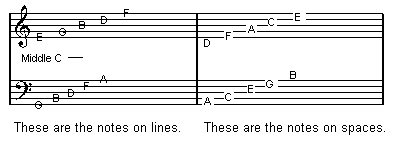|
Grandstaff, Clefs, Spaces and Lines |
The "Grand Staff" is what musicians first wrote on in the past. This could be considered one "big" staff but this format has changed over the years. Now, the Staff is divided into two "systems" (for piano music) which is a series of five lines and four spaces within these to represent different notes. The "Middle C" note appears in-between each set of five lines (and is considered to sit on a line which only appears when that note is written.) One should notice the line on the far left of the staff that joins both systems together. This indicates piano music specifically and individual systems are written for individual instruments, like those in an orchestra for example. See the following diagram for an example.

The top system is usually the "Treble Clef" and is so indicated by the Treble Clef sign. The bottom system is usually the "Bass Clef" and is so indicated by the Bass clef sign.
| To show the upper half of the piano, we use a sign called the TREBLE CLEF |  |
| To show the lower half of the piano, we use a sign called the BASS CLEF |  |
The lines and spaces of each clef represent different notes. Consequently, the first line of the treble clef represents the note "E", the second line is "G", the third line is "B", the forth line is "D" and the top (or fifth) line is "F". Conversely, the first space if the treble clef is "F", the second space is "A", the third space is "C" and the top space is "E".
A way to remember this is the sentence " Every Good Boy Deserves Fun" for the lines and the spaces spell the word FACE. The first (or bottom) line if the Bass clef represents a "G", the second line is "B", the third line is "D", the fourth line is "F" and the fifth line is "A". The first (or bottom) space in the Bass Clef represents an "A", the second space is "C", the third space is "E" and the fourth space is "G". The sentence " Good Boys Deserve Fun Always" helps to remember the lines of the bass clef. The first space of the bass clef represents the note "A", the second space is a "C", the third space is a "E" and the fourth space is a "G". The sentence " All Cows Eat Grass" helps us to learn the spaces of the bass clef.

There are sometimes notes that appear above or below these lines and spaces. They appear on lines (or spaces) that look like they were added to the top of these clefs. These lines are called "ledger lines" and only appear when necessary for the notes that need them; otherwise they are not written and assumed to be there.